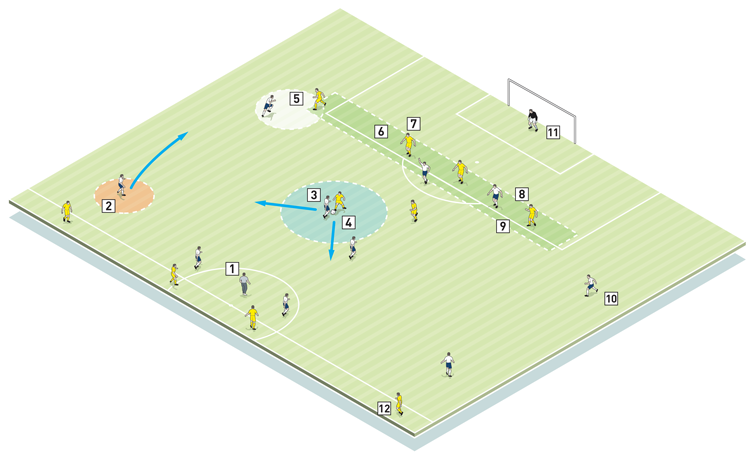New club, new players – the first training session

When you join a new club there are a hundred things to think about, but of greatest importance is getting to grips with the players and learning as much as you can about them in a short space of time. That can be easier said than done – the matches come thick and fast and training time is limited, but I’ve had nine occasions in my career where I’ve gone into a club to give that first training session as a manager, and I believe I now have a blueprint that works.
Meet and greet
The first thing is to meet and greet the players. On most occasions a new man comes into a club because things perhaps haven’t gone to plan with the previous manager, so it’s a case of letting them know how the future will be, and by that I mean in a practical sense. I’m not going to make big promises to players, but what I can guarantee them is plenty of hard work; hard work in terms of fitness, shape and general training.
I’ll always spend time emphasising teamwork, and no matter what has happened before, remind them that no one individual is above anyone else. But I would not ever reference the previous manager; I only emphasise the future of the team and what the philosophy for games and training will be, and in my mind you can crystallise those quite easily – no lateness and no sloppy attitude, because when we come to work it is exactly that, work.
Assessing players
It’s obviously not a privilege most managers or coaches can enjoy when they arrive at a new club, but upon joining a Premier League outfit the chances are you will be aware of all the players, such is the exposure of the game. Indeed, you may have even worked with some of them previously.
Of course there’s lots of preparation that can be done away from the training pitch. And yes, I will watch tapes of previous games, looking at individual and team performances as well as checking statistics.
In my experience, what’s interesting is that some players will be better than you thought and some worse, but ultimately you learn about their ability and character by working with them.
Onto the training pitch
I’ll always base the first training session when arriving at a club around match situations, drills and ‘keep ball’ exercises. The reason for this is because I want players to play naturally, but with the opportunity to show me energy levels and performance; I want to see the intensity of the players.
Some new managers choose to stand back on a first session and just view from the side, but I will always take the session myself – if you do that it sets a marker for what is expected because, ultimately, you get one chance to make a first impression and that can set the tone for the future.
And you won’t get it right every time. Going into most clubs, the most difficult thing can be remembering everybody’s name – and not just the players’ names either, because there are support staff too.
What do I get the players to do?
After a chat with the players and a good warm-up, we may run a 4v4 possession game in a 15x15-yard area, but I’m most interested to see how players respond when setting up 11v11 on a full pitch. After all, a first training session presents the opportunity to put players in their positions so I can see what they’re about. I have not worked with them before so it gives me a good idea of strengths and weaknesses in-situ.
It’s worth remembering too, this is a tense time for the players as well, and we have to factor that in. So on a first training session I do not want to ask players to do things they are not capable of or comfortable with.
So I will stand in the centre circle and start play. The front four on both sides do not defend past the halfway line so it’s basically 10v6 for the attacking team (1).
1

1. My position to enable a view of all scenarios
2. How willing or confident are our midfielders to build overloads in the middle of the park?
3. Can we provoke transitions of play from 1v1 scenarios in midfield?
4. Is the midfielder aware of opportunities to switch left and right, or drive past his man to the edge of the box?
5. Can we provoke individual defending scenarios, or opportunities where wingers are invited to take a man on?
6. How solid is the positioning and communication of the back four?
7. How do defenders react when the ball is played in to one of the centre-forwards?
8. How good is the communication between the front two?
9. How does the other centre-forward react when his team mate has the ball? Does he instinctively make a run into space?
10. Is the winger finding space, and is he willing to attack the near post should the ball end up at the opposite winger’s feet?
11. How well is the keeper commanding his box and the players in front of him?
12. During an attack the opposition forwards can only defend up to the half way line, effectively making a 10v6 scenario
Although this set-up is simple and uncomplicated, it enables me to examine some key playing situations:
• Back four defending
• Individual defending
• Transition of play
• Counter-attack
• Pace of play
Once whites have attacked we reset play at the halfway line and invite yellows to now attempt to find a route to goal in a 10v6.
What are the key things to look out for?
As discussed, the most important aspect of this training session is to observe and record every possible element of how a player approaches situations in the game. Naturally we’re looking for body shape, positioning and the ability to go from defence to attack. But more than that, I want to judge each player’s work rate, energy, attitude, decision-making and ability to communicate with team mates. Assessing this in a first session is important, but ultimately this is information that will be accumulated over the course of many sessions and many weeks, so that I can truly gauge who the players are who can help me take the club forward and achieve the goals I have set out.
Sessions going forward
Sessions will be planned around what I see initially and what we need to do more of, but the most important thing is to start laying down the team strategy and shape. Some players will buy into it, some not so much, and that’s inevitable. But the important thing is you’re off and running with your new team. Very quickly you will learn who you can rely on and how best you can commence getting the team to play the way you want.
Editor's Picks
Attacking transitions
Deep runs in the final third
Using the goalkeeper in build-up play
Intensive boxes drill with goals
Penetrating the final third
Creating and finishing
My philosophy
Pressing initiation
Compact team movement
Coaches' Testimonials

Alan Pardew

Arsène Wenger

Brendan Rodgers

Carlos Carvalhal

José Mourinho

Jürgen Klopp

Pep Guardiola

Roy Hodgson

Sir Alex Ferguson

Steven Gerrard
Coaches' Testimonials

Gerald Kearney, Downtown Las Vegas Soccer Club

Paul Butler, Florida, USA

Rick Shields, Springboro, USA

Tony Green, Pierrefonds Titans, Quebec, Canada
Join the world's leading coaches and managers and discover for yourself one of the best kept secrets in coaching. No other training tool on the planet is written or read by the calibre of names you’ll find in Elite Soccer.
In a recent survey 92% of subscribers said Elite Soccer makes them more confident, 89% said it makes them a more effective coach and 91% said it makes them more inspired.
Get Monthly Inspiration
All the latest techniques and approaches
Since 2010 Elite Soccer has given subscribers exclusive insight into the training ground practices of the world’s best coaches. Published in partnership with the League Managers Association we have unparalleled access to the leading lights in the English leagues, as well as a host of international managers.
Elite Soccer exclusively features sessions written by the coaches themselves. There are no observed sessions and no sessions “in the style of”, just first-hand advice delivered direct to you from the coach.









